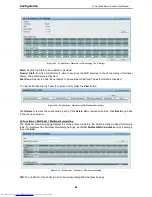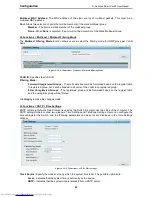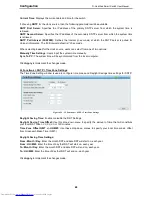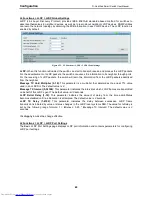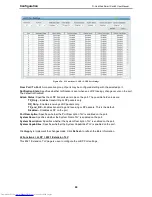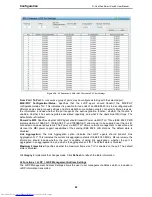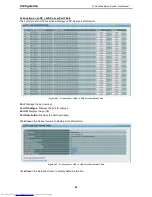
Configuration
D-Link Web Smart Switch User Manual
3
3
9
9
Figure 4.41 – L2 Functions > Spanning Tree > STP Global Settings
STP Version:
You can choose RSTP or STP Compatible. The default setting is
RSTP
.
Bridge Priority:
This value, between 0 and 61440, specifies the priority for forwarding packets. The lower
the value, the higher the priority. The default is
32768
.
TX Hold Count (1-10):
Specifies the maximum number of Hello packets transmitted per interval. The count
can be specified from 1 to 10. The default is
6.
Maximum Age (6-40):
This value may be set to ensure that old information does not endlessly circulate
through redundant paths in the network, preventing the effective propagation of the new information. Set by
the Root Bridge, this value will aid in determining that the Switch has spanning tree configuration values
consistent with other devices on the bridged LAN. If the value ages out and a BPDU has still not been
received from the Root Bridge, the Switch will start sending its own BPDU to all other switches for permission
to become the Root Bridge. If it turns out that the Switch has the lowest Bridge Identifier, it will become the
Root Bridge. A time interval may be chosen between 6 and 40 seconds. The default value is
20
. (Maximum
Age must have a value larger than Hello Time)
Hello Time (1-2):
The user may set the time interval between transmissions of configuration messages by
the root device, thus stating that the Switch is still functioning. The default is
2
seconds.
Forward Delay (4-30):
This sets the maximum amount of time that the root device will wait before changing
states. The default is
15
seconds.
Root Bridge:
Displays the MAC address of the Root Bridge.
Root Cost:
Display the cost of the Root Bridge.
Root Maximum Age:
Displays the Maximum Age of the Root Bridge.
Root Forward Delay:
Displays the Forward Delay of the Root Bridge.
Root port:
Displays the root port.
Click
Apply
for the settings to take effect. Click
Refresh
to renew the page.
This window allows the user to configure STP parameters for individual ports or a range of ports. In addition
to setting Spanning Tree parameters for use on the switch level, the Switch allows for the configuration of the
groups of ports, each port-group of which will have its own spanning tree, and will require some of its own
configuration settings.
L2 Functions > Spanning Tree > STP Port Settings
An STP Group spanning tree works in the same way as the switch-level spanning tree, but the root bridge
concept is replaced with a root port concept. A root port is a port of the group that is elected based on port
priority and port cost, to be the connection to the network for the group. Redundant links will be blocked, just
as redundant links are blocked on the switch level.
The STP on the switch level blocks redundant links between switches (and similar network devices). The
port level STP will block redundant links within an STP Group.
It is recommanded to define an STP Group to correspond to a VLAN group of ports.






















